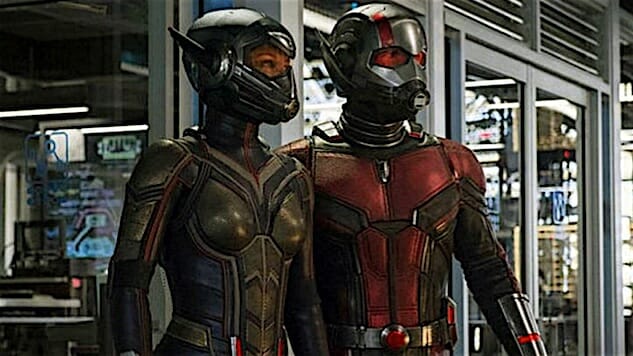Ant-Man and the Wasp

1. Ant-Man is the least essential of all the Marvel Cinematic Universe characters, and Ant-Man and the Wasp is unquestionably the least essential of the MCU movies, occasionally agreeable but ultimately disposable, a bauble that feels less like a fun side journey and more like a waste of everybody’s time. This year already, Marvel has released two of their most important films, and their two biggest hits: Black Panther, which redefined exactly what a blockbuster could be, and Avengers: Infinity War, which wasn’t nearly as good but still upended the entire MCU in a way that we’re still all recovering from. After those two movies, we’re supposed to care about some people who can make themselves small? Outside the context of the whole MCU world, this is just a minor movie, a cheerful if empty entertainment. But since when are you supposed to be context-free in the MCU? It feels like Marvel twiddling its thumbs.
2. In this film, Scott Lang (Paul Rudd) is still under house arrest after the events of Captain America: Civil War but days away from release when he receives a message from Janet (Michelle Pfeiffer), the mother of Hope/Wasp (Evangeline Lilly) and wife of Hank Pym (Michael Douglas), who has been trapped in the Quantum Realm for 30 years and needs him to gather her family so they can save her. Meanwhile, there’s a former colleague of Pym’s (Laurence Fishburne) who wants to help save the life of his adopted daughter Ghost (Hannah John-Kamen) who is suffering from some sort of quantum displacement, and oh yeah there’s Walton Goggins as an evil entrepreneur who wants Pym’s technology and can you tell we’re in yet another wildly overplotted Marvel movie? One of these days they’re going to make a movie where four superheroes are trapped in a room and just fight for 90 minutes. That would be fine. That would be a relief.
3. Much of the fun of the Ant-Man franchise is playing with perspective, the idea that a superhero can have the strength of a full-sized superhero but be the size of, well, an ant. I still think Edgar Wright would have played around with this idea more than Peyton Reed does, but nonetheless, the movie does have its moments of inspired silliness. I enjoyed the moment when Scott waits for his usual insect to fly him off and away but keeps having his rides intercepted by hungry seagulls. (“Murderers!”) And there’s a big chase sequence that makes up the last half hour of the film that makes good use of San Francisco as a location, particularly the idea that its hills and turns, so glamorized in cinematic chase sequences of the past, take on an entirely different dimension when everyone’s sizes keep getting blown up and shrunken down. The movie’s ending has the jazzy, goofy rhythm that you want from a movie like this.
-

-

-

-

- Curated Home Page Articles By Test Admin October 21, 2025 | 3:10pm
-

- Curated Home Page Articles By Test Admin October 21, 2025 | 2:57pm
- Urls By Test Admin October 21, 2025 | 2:57pm
- Curated Home Page Articles By Test Admin October 21, 2025 | 2:55pm
-

-

-

-

-

-

-

-

-

-

-

-

-

-

-

-

-

-

-

-

-

-

-

-

-

-

-

-

-

-

-




































